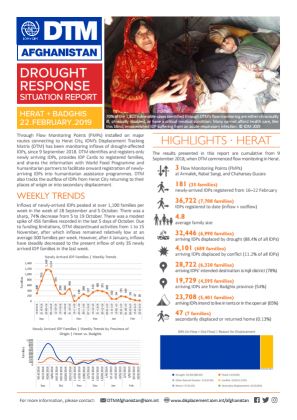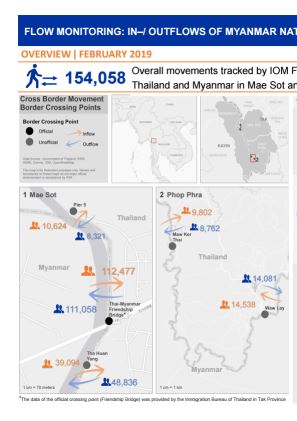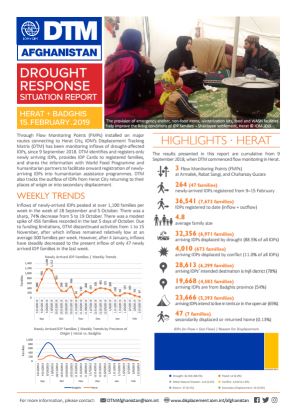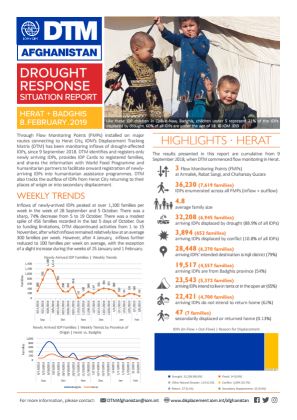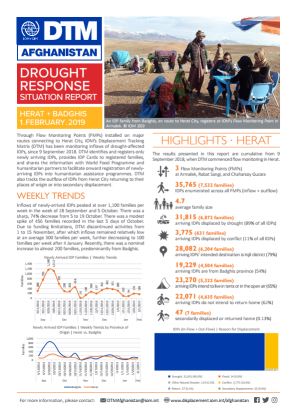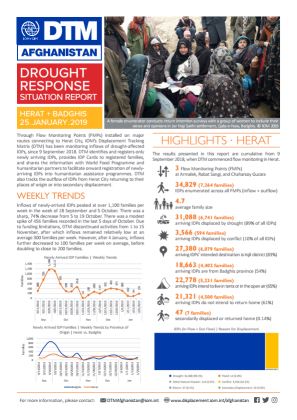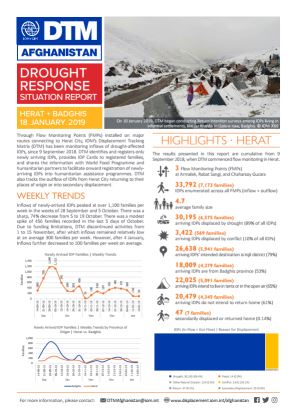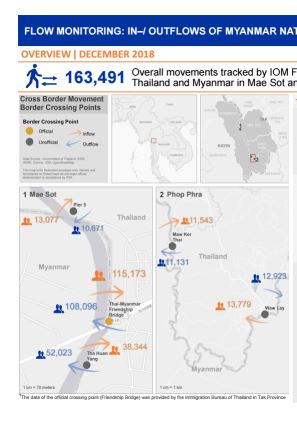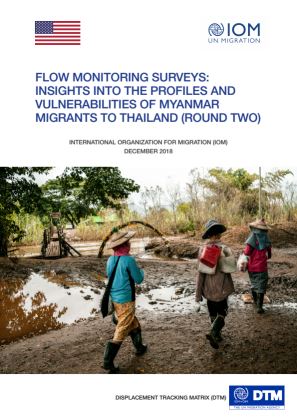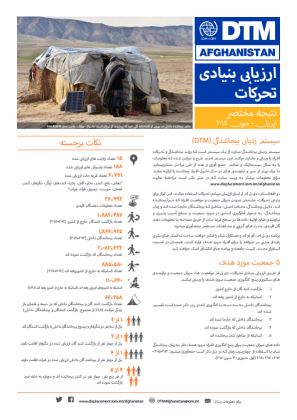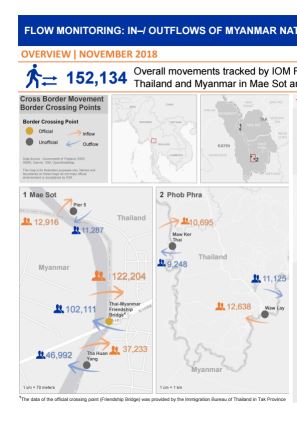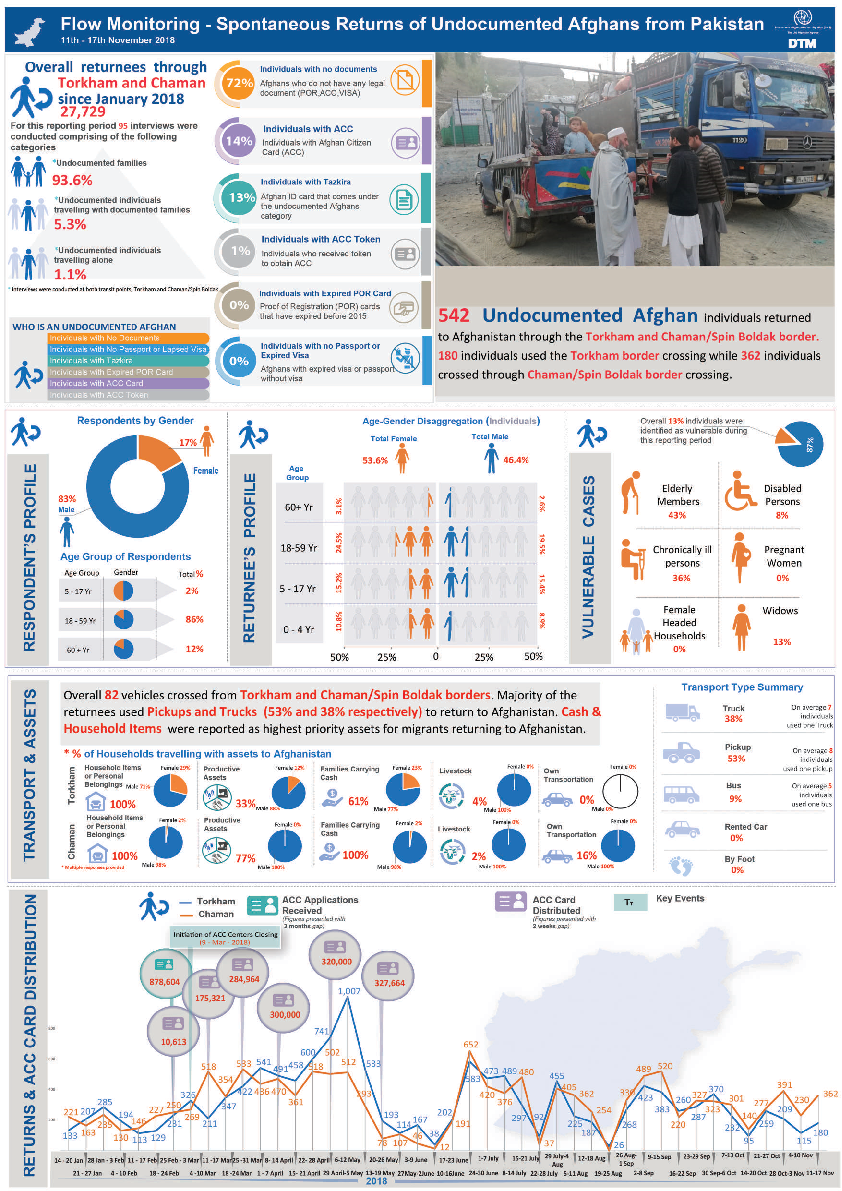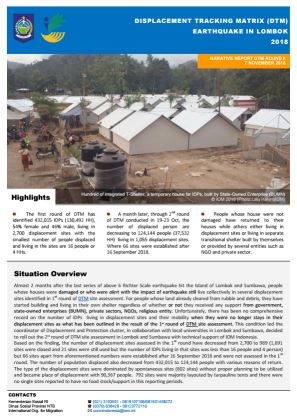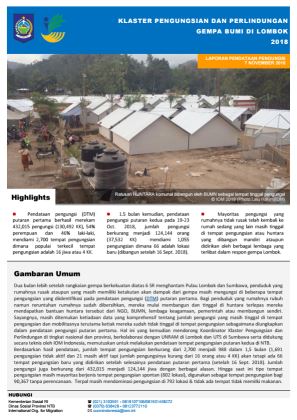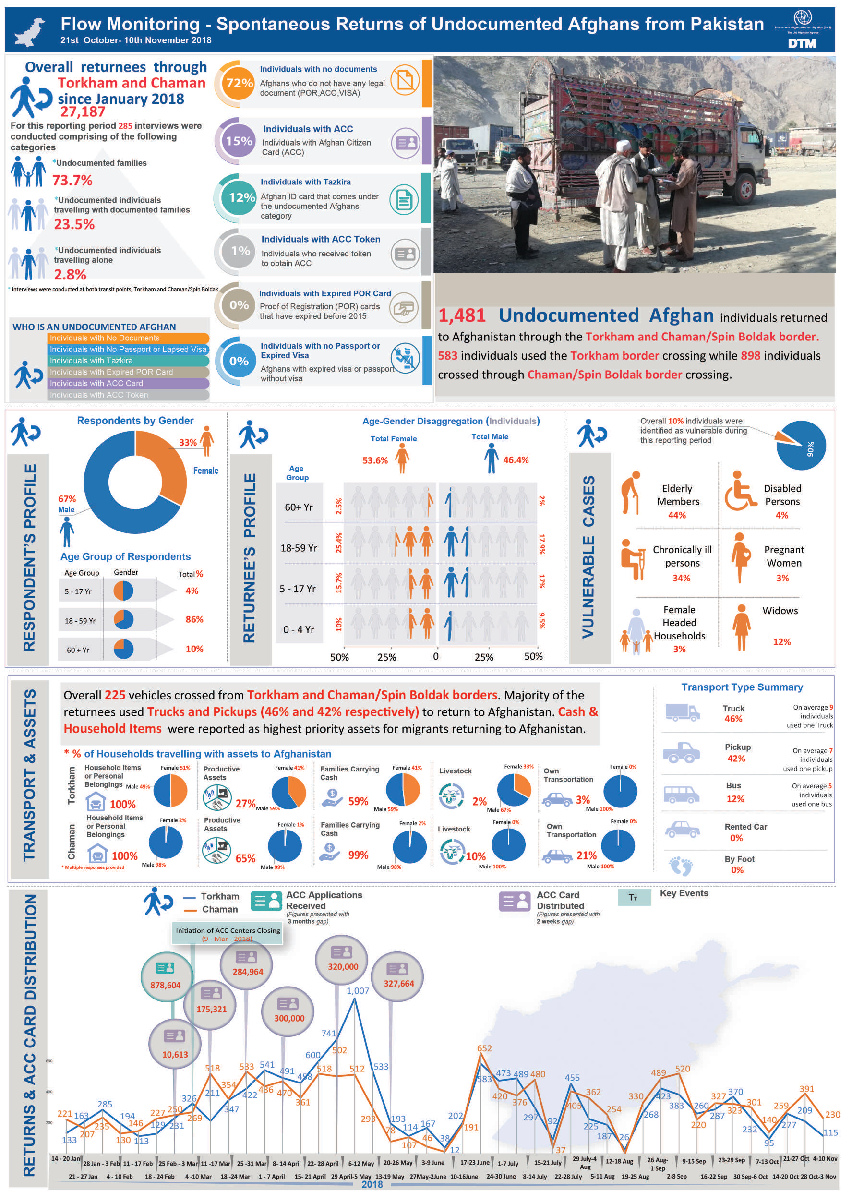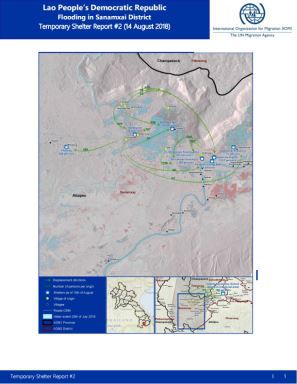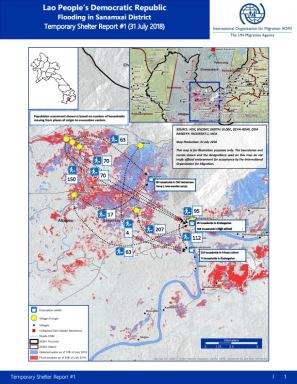-
Countries
-
Data and Analysis
-
Special Focus
-
Crisis Responses
Asia and the Pacific
DTM Asia and the Pacific
DTM Operations in the region
- Active DTM operation
- Past DTM operation
Afghanistan — Drought Response Situation Report (22 February 2019)
Through Flow Monitoring Points (FMPs) installed on major routes connecting to Herat City, IOM’s Displacement Tracking Matrix (DTM) has been monitoring inflows of drought-affected IDPs, since 9 September 2018.
Afghanistan — Drought Response Situation Report (01 March 2019)
Through Flow Monitoring Points (FMPs) installed on major routes connecting to Herat City, IOM’s Displacement Tracking Matrix (DTM) has been monitoring inflows of drought-affected IDPs, since 9 September 2018.
Afghanistan — Baseline Mobility Assessment Summary Results (October—December 2018)
In Afghanistan, DTM employs the Baseline Mobility Assessment tool, designed to track mobility, determine the population sizes and locations of forcibly displaced people, reasons for displacement, places of origin, displacement locations and times of displacement, including basic demographics, as
Thailand — Flow Monitoring of Myanmar nationals to and from Thailand (February 2019)
In February 2019, 154,058 movements (74,058 inflows and 80,000 outflows) of Myanmar nationals between Thailand and Myanmar were tracked by IOM Flow Monitoring Points (FMPs) in the Mae Sot and Phop Phra districts of Tak province, Thailand.
Afghanistan — Drought Response Situation Report (15 February 2019)
Through Flow Monitoring Points (FMPs) installed on major routes connecting to Herat City, IOM’s Displacement Tracking Matrix (DTM) has been monitoring inflows of drought-affected IDPs, since 9 September 2018.
Afghanistan — Drought Response Situation Report (8 February 2019)
Through Flow Monitoring Points (FMPs) installed on major routes connecting to Herat City, IOM’s Displacement Tracking Matrix (DTM) has been monitoring inflows of drought-affected IDPs, since 9 September 2018.
Afghanistan — Drought Response Situation Report (1 February 2019)
Through Flow Monitoring Points (FMPs) installed on major routes connecting to Herat City, IOM’s Displacement Tracking Matrix (DTM) has been monitoring inflows of drought-affected IDPs, since 9 September 2018.
Thailand — Flow Monitoring of Myanmar nationals to and from Thailand (January 2019)
In January 2019, 160,208 movements (80,447 inflows and 79,761 outflows) of Myanmar nationals between Thailand and Myanmar were tracked by IOM Flow Monitoring Points (FMPs) in the Mae Sot and Phop Phra districts of Tak province, Thailand.
Afghanistan — Drought Response Situation Report (25 January 2019)
Inflows of newly-arrived IDPs peaked at over 1,100 families per week in the week of 28 September and 5 October. There was a sharp, 74% decrease from 5 to 19 October. There was a modest
Afghanistan — Drought Response Situation Report: Herat and Badghis (9 September 2018—18 January 2019)
Through Flow Monitoring Points (FMPs) installed on major routes connecting to Herat City, IOM’s Displacement Tracking Matrix (DTM) has been monitoring inflows of drought-affected IDPs, since 9 September 2018.
Thailand — Flow Monitoring of Myanmar nationals to and from Thailand (December 2018)
In December 2018, 163,491 movements (76,743 inflows and 86,748 outflows) of Myanmar nationals between Thailand and Myanmar were tracked by IOM Flow Monitoring Points (FMPs) in the Mae Sot and Phop Phra districts of Tak province, Thailand.
Thailand — Flow Monitoring Surveys: Insights into the Profiles and Vulnerabilities of Myanmar Migrants to Thailand Round 2 (December 2018)
From mid-August until mid-October 2018, IOM Thailand conducted a second round of data collection in the districts of Mae Sot and Phop Phra in Tak Province, Thailand. A total of 3,233 Myanmar nationals were surveyed, of whom 3,013 were identified as migrant workers.
Afghanistan — Baseline Mobility Assessment Summary Results (April—June 2018) [Dari]
In Afghanistan, DTM employs the Baseline Mobility Assessment tool, designed to track mobility, determine the population sizes and locations of forcibly displaced people, reasons for displacement, places of origin, displacement locations and times of displacement, including basic demographic
Pakistan — Flow Monitoring of Undocumented Afghan Returnees from Pakistan (2-8 December 2018)
This weekly situation report covers the reporting period between 2 and 8 December 2018. 270 undocumented Afghan individuals returned to Afghanistan through the Torkham and Chaman / Spin Boldak border.
Thailand — Flow Monitoring of Myanmar nationals to and from Thailand (November 2018)
In November 2018, 152,134 movements (73,482 inflows and 78,652 outflows) were tracked by IOM Flow Monitoring Points (FMPs) of Myanmar nationals between Thailand and Myanmar in the Mae Sot and Phob Phra districts.
Vanuatu — DTM Round 3 Maewo Displacement Map (October 22, 2018)
DTM Round 3 Evacuee Sites on Maewo as of October 22, 2018
Vanuatu — DTM Round 3 Displacement Snapshot (December 4, 2018)
Ambae Evacuee Response, VanuatuDTM Round 3 (December 4, 2018)
Vanuatu — DTM Round 3 Santo Displacement Map (October 22, 2018)
DTM Round 3 Evacuee Sites in Sanma as of October 22, 2018
Pakistan — Flow Monitoring of Undocumented Afghan Returnees from Pakistan (11-17 November 2018)
This weekly situation report covers the reporting period between 11 and 17 November 2018. 542 undocumented Afghan individuals returned to Afghanistan through the Torkham and Chaman/Spin Boldak border.
Indonesia — Lombok Narrative Report 2 (7 November 2018)
Since the first DTM round, the number of population displaced has decreased from 432,015 to 124,144 people.
Indonesia — Lombok Narrative Report 2 (7 November 2018)
Pendataan pengungsi (DTM) putaran pertama berhasil merekam 432,015 pengungsi (130,492 KK), 54% perempuan dan 46% laki-laki, mendiami 2,700 tempat pengungsian dimana populai terkecil tempat pengungsian adalah 16 jiwa atau 4 KK.
Pakistan — Flow Monitoring of Undocumented Afghan Returnees from Pakistan (21 October - 10 November 2018)
1,481 undocumented Afghan individuals returned to Afghanistan throgh the Torkham and Chaman/Spin Boldak border. 583 individuals used the Torkham border crossing while 898 individuals crossed through Chaman/Spin Boldak border crossing.
Lao PDR — Temporary Shelter Report 2 (14 August 2018)
The International Organization for Migration (IOM) deployed staff to support the Joint Rapid Assessment led by the Ministry of Health, focusing specifically on information regarding the camps / temporary shelters for those displaced by the flooding in Attapeu, Sanamxai District right after the fl
Lao PDR — Temporary Shelter Report 1 (31 July 2018)
IOM deployed staff to support the Ministry of Health (MOH) Health and WASH cluster assessments to focus specifically on information regarding the camps / temporary shelters for those displaced by the flooding in Attapeu, Sanamxai District.
Pagination
Pagination
- First page
- Previous page
- 1
- 2
- 3
- 4
- 5
- 6
Pagination
- First page
- Previous page
- 1
- 2
- 3
- 4
- 5
- 6
- 7
